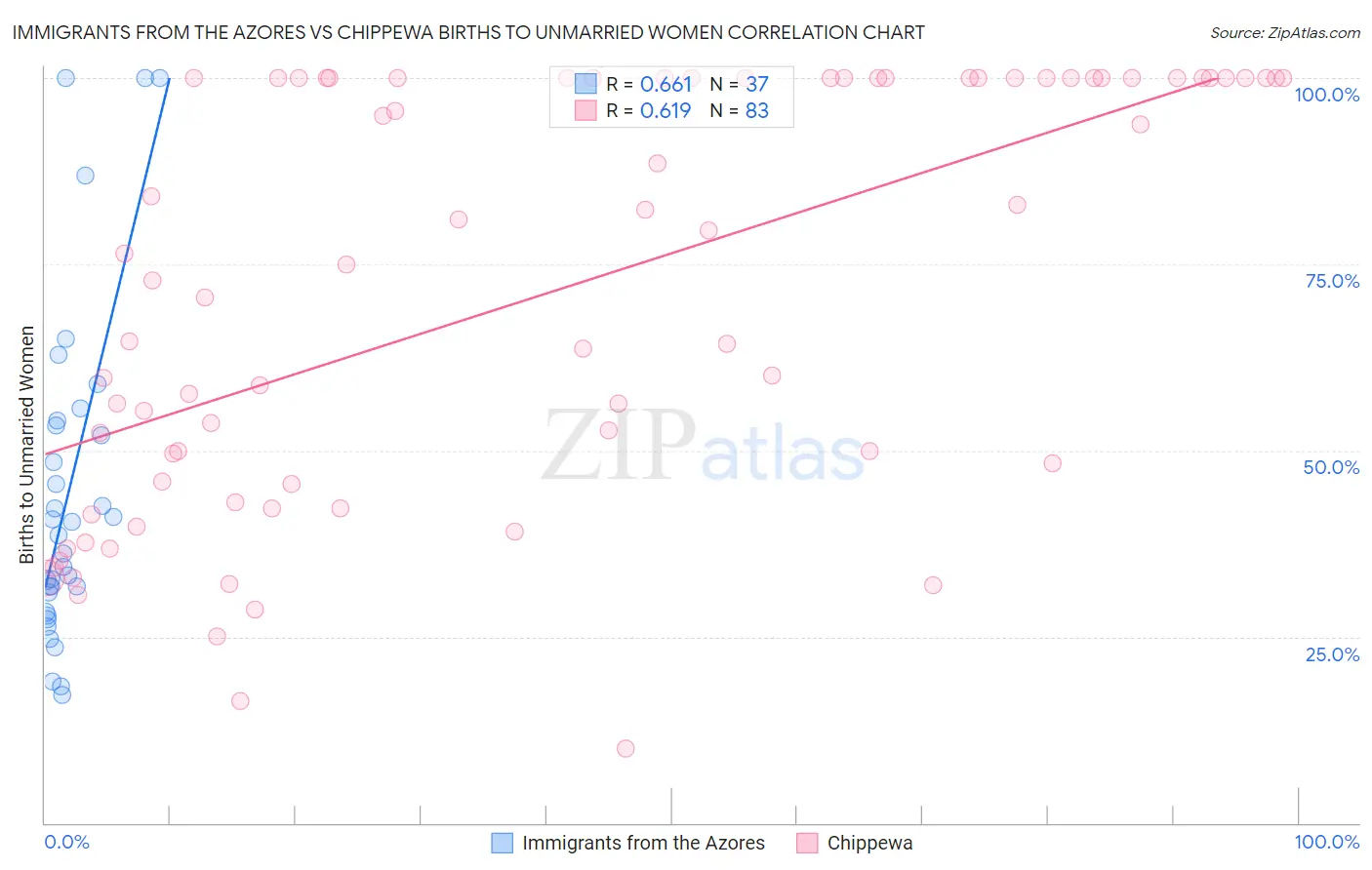Immigrants from the Azores vs Chippewa Births to Unmarried Women
COMPARE
Immigrants from the Azores
Chippewa
Births to Unmarried Women
Births to Unmarried Women Comparison
Immigrants from the Azores
Chippewa
39.6%
BIRTHS TO UNMARRIED WOMEN
0.0/ 100
METRIC RATING
311th/ 347
METRIC RANK
42.6%
BIRTHS TO UNMARRIED WOMEN
0.0/ 100
METRIC RATING
330th/ 347
METRIC RANK
Immigrants from the Azores vs Chippewa Births to Unmarried Women Correlation Chart
The statistical analysis conducted on geographies consisting of 45,022,253 people shows a significant positive correlation between the proportion of Immigrants from the Azores and percentage of births to unmarried women in the United States with a correlation coefficient (R) of 0.661 and weighted average of 39.6%. Similarly, the statistical analysis conducted on geographies consisting of 205,326,129 people shows a significant positive correlation between the proportion of Chippewa and percentage of births to unmarried women in the United States with a correlation coefficient (R) of 0.619 and weighted average of 42.6%, a difference of 7.7%.

Births to Unmarried Women Correlation Summary
| Measurement | Immigrants from the Azores | Chippewa |
| Minimum | 17.2% | 10.0% |
| Maximum | 100.0% | 100.0% |
| Range | 82.8% | 90.0% |
| Mean | 44.2% | 71.0% |
| Median | 38.6% | 75.0% |
| Interquartile 25% (IQ1) | 29.6% | 45.5% |
| Interquartile 75% (IQ3) | 53.6% | 100.0% |
| Interquartile Range (IQR) | 24.0% | 54.5% |
| Standard Deviation (Sample) | 22.2% | 27.9% |
| Standard Deviation (Population) | 21.9% | 27.7% |
Demographics Similar to Immigrants from the Azores and Chippewa by Births to Unmarried Women
In terms of births to unmarried women, the demographic groups most similar to Immigrants from the Azores are U.S. Virgin Islander (39.6%, a difference of 0.020%), Immigrants from Dominica (39.5%, a difference of 0.23%), African (39.7%, a difference of 0.36%), Immigrants from Caribbean (39.8%, a difference of 0.65%), and Dominican (39.8%, a difference of 0.69%). Similarly, the demographic groups most similar to Chippewa are Paiute (42.5%, a difference of 0.40%), Immigrants from Cabo Verde (42.2%, a difference of 1.0%), Tsimshian (42.2%, a difference of 1.1%), Immigrants from Cuba (41.5%, a difference of 2.8%), and Cheyenne (41.3%, a difference of 3.1%).
| Demographics | Rating | Rank | Births to Unmarried Women |
| Immigrants | Dominica | 0.0 /100 | #310 | Tragic 39.5% |
| Immigrants | Azores | 0.0 /100 | #311 | Tragic 39.6% |
| U.S. Virgin Islanders | 0.0 /100 | #312 | Tragic 39.6% |
| Africans | 0.0 /100 | #313 | Tragic 39.7% |
| Immigrants | Caribbean | 0.0 /100 | #314 | Tragic 39.8% |
| Dominicans | 0.0 /100 | #315 | Tragic 39.8% |
| Apache | 0.0 /100 | #316 | Tragic 39.9% |
| Immigrants | Dominican Republic | 0.0 /100 | #317 | Tragic 40.1% |
| Immigrants | Bahamas | 0.0 /100 | #318 | Tragic 40.1% |
| Yakama | 0.0 /100 | #319 | Tragic 40.3% |
| Crow | 0.0 /100 | #320 | Tragic 40.4% |
| Bahamians | 0.0 /100 | #321 | Tragic 40.8% |
| Cajuns | 0.0 /100 | #322 | Tragic 41.0% |
| Sioux | 0.0 /100 | #323 | Tragic 41.0% |
| Cape Verdeans | 0.0 /100 | #324 | Tragic 41.3% |
| Cheyenne | 0.0 /100 | #325 | Tragic 41.3% |
| Immigrants | Cuba | 0.0 /100 | #326 | Tragic 41.5% |
| Tsimshian | 0.0 /100 | #327 | Tragic 42.2% |
| Immigrants | Cabo Verde | 0.0 /100 | #328 | Tragic 42.2% |
| Paiute | 0.0 /100 | #329 | Tragic 42.5% |
| Chippewa | 0.0 /100 | #330 | Tragic 42.6% |